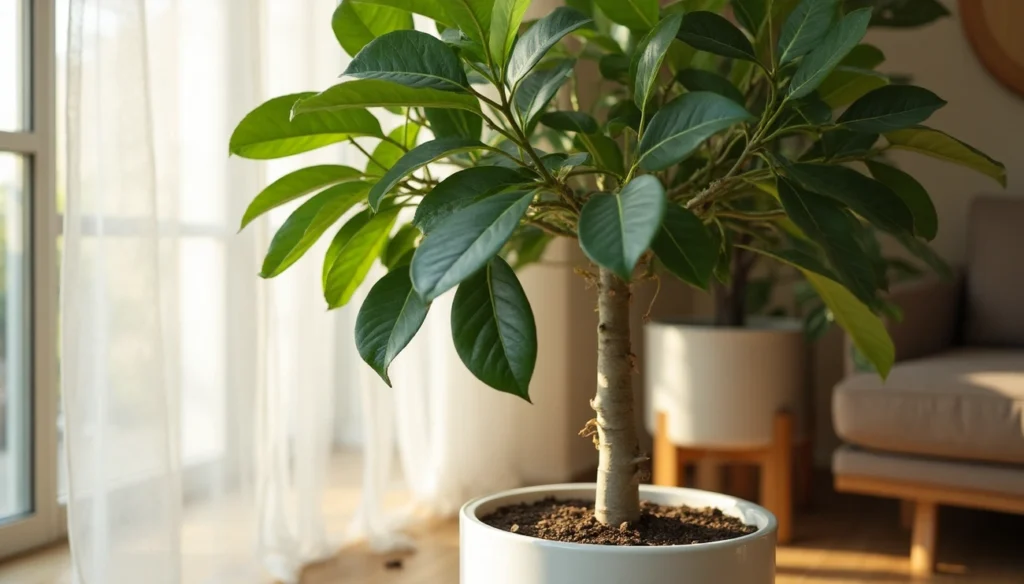The Ficus benghalensis isn’t just another houseplant – it’s India’s national tree, and for good reason. This majestic beauty develops those Instagram-worthy aerial roots as it matures, eventually thickening into part of the trunk for a truly show-stopping display. While it needs some specific care, most plant parents find it refreshingly forgiving compared to its temperamental cousin.
Don’t let anyone tell you this is a beginner plant, though. Your Ficus Audrey rewards attention with spectacular growth – we’re talking up to 6 feet of gorgeous greenery that makes every room feel like a tropical retreat. Plant enthusiasts rave about it being one of the best indoor specimens you can grow.
Ready to master Ficus Audrey care? I’ll share everything you need to know about light, watering, pruning, and troubleshooting – all the secrets to keeping this beauty thriving in your home.
Getting the Environment Right
Think of your Ficus Audrey as a tropical tree that’s adapted to indoor life – it still craves those same conditions that made it thrive in its native India.
Light requirements that actually work
Your Ficus Audrey needs high levels of filtered light to stay lush and full. This isn’t a low-light plant (despite what some people claim) – skimp on brightness and you’ll get leggy, sparse growth that looks nothing like those gorgeous specimens you see online.
East or west-facing windows work perfectly. Got a south-facing window? Place your plant a few feet back to avoid leaf scorch. Too much direct sun damages those beautiful leaves, but you can gradually acclimate your plant if you want to try a sunnier spot.
Here’s what happens when you get it wrong: insufficient light creates that disappointing stretched-out look, while harsh direct sun leaves brown, crispy patches on the foliage.
Temperature and humidity sweet spots
Keep your plant comfortable between 60-75°F (15-24°C). Sudden temperature swings stress the plant terribly – anything below 55°F can trigger leaf drop.
Humidity levels between 40-60% keep your Ficus Audrey happy. When the air gets too dry, you’ll notice brown leaf edges and increased leaf drop (not the look you’re going for).
Quick humidity fixes that actually work:
- Mist with room-temperature water regularly
- Run a humidifier nearby
- Set up a pebble tray with water under the pot
- Group it with other plants for a natural humidity boost
Where to place it (and where not to)
Once you find the perfect spot with several hours of bright, indirect light, resist the urge to move your plant around. Ficus plants hate being relocated and will show their displeasure through leaf drop.
Skip these problem areas: near air conditioning units, heaters, or doors that open frequently. The drafts will stress your plant every single time. Bathrooms and laundry rooms can provide extra humidity if your home runs particularly dry.
Get these basics right, and your Ficus Audrey will reward you with years of healthy growth.
Watering and Soil Essentials
Here’s the thing about Ficus Audrey care – get the watering right, and you’re halfway to success. While this beauty is more forgiving than the fiddle leaf fig, moisture balance still makes or breaks your plant.
How often to water your Audrey ficus
Forget the watering schedule apps on your phone. Your Ficus Audrey wants to dry out slightly between waterings, so check the top 2-3 inches of soil before reaching for that watering can. Stick your finger right into the soil – if it’s dry, it’s time to water thoroughly until you see water flowing through the drainage holes. (Always empty that saucer afterward – standing water is your plant’s enemy.)
Most plants need watering every 7-10 days during growing season, then less frequently in winter. But here’s what I’ve learned: watch your plant, not the calendar. Curling leaves? Your tree is thirsty. Drooping foliage means it needs a good drink.
Choosing the right soil mix
The secret to happy roots? A mixture of indoor potting soil, perlite, and sand that drains beautifully while holding just enough moisture. Think of it like a sponge that doesn’t stay soggy.
Try these additions for even better drainage:
- Cactus soil mixed with extra perlite
- Orchid bark for improved air circulation
- A handful of sand to prevent soil compaction
Any quality potting mix works as long as it drains well. Just make sure your pot has drainage holes – water pooling at the bottom spells trouble.
Avoiding overwatering and root rot
Even though Ficus Audrey tolerates more than other ficus varieties, overwatering remains the biggest threat. Root rot develops fast when soil stays waterlogged.
Watch for these warning signs:
- Yellow leaves starting at the bottom (especially near soil level)
- Brown spots appearing in leaf centers
- Leaves dropping from the plant’s base
Suspect overwatering? Stop watering immediately and let the soil dry completely – sometimes this takes 2-3 weeks. For severe cases, you might need to unpot the plant to check for mushy, black roots and replace the soil entirely.
Finding the right watering rhythm takes practice and depends on your home’s specific conditions. Trust your plant to tell you what it needs.
Pruning, Propagation, and Growth
Want to go from basic plant parent to Ficus Audrey expert? These pruning and propagation techniques will help you shape a stunning specimen while creating new plants to share (or hoard – we don’t judge).
Ficus Audrey pruning tips for shape and health
Spring and summer are your pruning sweet spot when your plant is actively growing. Dead or damaged leaves? Remove those any time of year. But save the major reshaping for warmer months when your plant can bounce back quickly.
Here’s your pruning prep checklist: lay down newspaper or protective sheets because that sticky sap will stain floors and irritate your skin. Trust me on this one.
Your pruning game plan:
- Sharp, clean shears are non-negotiable – cut at 90-degree angles just above a node
- Gloves protect your hands from that irritating latex sap
- Target leggy or lopsided branches to create balanced growth
- Never prune more than 10% at once (your plant will thank you)
Beyond keeping things pretty, pruning controls height and encourages branching. Think of it as giving your plant a strategic haircut that promotes fuller growth.
How to propagate your Audrey Ficus tree
Stem cuttings give you the easiest path to new plants. Choose a young branch with 4-5 healthy leaves and make a clean cut about 3 inches below the lowest leaf. That sap will start flowing immediately – keep paper towels handy until it scabs over.
Your cutting can go straight into water until roots reach 2-3 inches, or directly into soil with rooting hormone for faster results. Air layering works brilliantly too – make an incision in a branch, pack it with sphagnum moss, wrap it securely, and wait for roots to develop before cutting and planting.
Encouraging fuller growth and branching
Does your Ficus Audrey look more like a single pole than a lush tree? You’ll need to coax it into branching. Pinching off the growth tip redirects energy to dormant nodes below, stimulating new branches. For taller plants, try notching – make a small ¼-inch cut into the trunk where you want branches to emerge.
This technique awakens dormant nodes by redirecting growth hormones to that specific area. Rotate your plant occasionally for even growth on all sides.
Here’s the reality check: Ficus Audrey responds slowly to these techniques, often taking 4-8 weeks to show new growth. Patience pays off with a fuller, more spectacular plant.
Repotting, Troubleshooting, and Long-Term Care
Your Ficus Audrey doesn’t need constant fussing, but knowing when to repot and how to spot problems early keeps it healthy for years to come.
When to repot your Ficus Audrey (and when not to)
Here’s something most plant parents get wrong: Ficus Audrey actually prefers being slightly root-bound. Don’t rush to repot every year – these plants thrive when their roots are snug. Wait 2-3 years between repotting, and only tackle this job during spring or early summer when your plant is actively growing.
Watch for these clear signs it’s time:
- Roots poking through drainage holes
- Roots circling the bottom of the pot
- Water running straight through without soaking in
- Growth has noticeably slowed despite good care
For successful repotting:
- Choose a pot just 2-4 inches larger in diameter
- Gently tease some soil from the roots
- Use fresh, well-draining soil mix
- Keep the root ball at the same level as before
- Water thoroughly when finished
Want to keep your plant the same size? Repot into the same container with fresh soil, trimming back some roots and foliage.
Yellow leaves? Here’s what your plant is telling you
Yellowing leaves often mean watering issues, but don’t panic – most problems are fixable. Older leaves naturally yellow and drop as part of the plant’s life cycle. But if newer leaves turn yellow with brown tips and yellow edges, you’re overwatering. Yellow leaves with crispy brown tips but no yellow edges? Your plant is thirsty.
Leaf drop usually happens after environmental changes or watering mistakes. Your Ficus Audrey might temporarily shed leaves after being moved to a new spot – this is normal stress, not a crisis. Sudden temperature changes or drafts from air conditioning can also trigger leaf loss.
Spotting and stopping common pests
Ficus Audrey’s sticky sap attracts sap-sucking pests, but regular checks catch problems early. Look for:
- Fine webbing on leaf undersides (spider mites)
- Tiny black flies around soil (fungus gnats)
- White cottony spots (mealybugs)
- Small brown bumps on stems (scale)
Keep humidity levels right and wipe leaves occasionally to prevent infestations. If pests appear, treat with insecticidal soap or neem oil weekly until they’re gone.
Self-watering planters: the game-changer for consistent care
Self-watering planters work brilliantly with Ficus Audrey because they provide steady moisture without the guesswork. Start by watering from the top for 2-4 weeks to encourage roots to grow toward the reservoir. Once established, let the reservoir empty completely between refills – this 1-3 day drying period prevents fungus gnats by keeping surface soil drier while roots drink from below.
Your Ficus Audrey Success Story Starts Now
Ficus Audrey care really isn’t as intimidating as it first appears. Once you understand this beauty needs bright indirect light, steady temperatures, and that crucial balance between moist and dry soil, you’re already ahead of the game. The secret lies in treating it like the tropical native it is – give it conditions that remind it of home, and it’ll reward you handsomely.
Getting the watering right makes all the difference. Check that soil regularly, ensure those drainage holes are doing their job, and remember that a well-draining soil mix is your best friend for preventing root rot. These basics will keep your plant healthy for years.
Here’s what makes Ficus Audrey care so rewarding: pruning and propagation let you actively shape your plant’s future. A strategic trim here and there keeps it looking gorgeous while encouraging that fuller growth everyone wants. Plus, propagating your own cuttings means you can share this stunning plant with friends (or just expand your own collection).
Don’t panic if you spot yellowing leaves or the occasional pest – these hiccups happen to even experienced plant parents. Quick action and the right adjustments usually solve most problems. Those self-watering planters can be game-changers for keeping moisture levels steady without the guesswork.
The real joy of growing a Ficus Audrey comes from watching it slowly develop those incredible aerial roots that make it such a conversation starter. Every plant has its own personality, so feel free to adapt these guidelines to what works in your specific space.
You’ve got everything you need to turn your Ficus Audrey into a thriving centerpiece that’ll be the envy of every plant lover who visits. Now get out there and show this beauty what good care looks like!
FAQs
Q1. Is the Ficus Audrey difficult to maintain?
While the Ficus Audrey requires specific care, it’s generally considered easier to maintain than some other Ficus varieties. With proper light, watering, and environmental conditions, it can thrive as an indoor plant. However, neglecting its care may lead to issues like leaf drop or pest susceptibility.
Q2. What causes brown tips on Ficus Audrey leaves?
Brown leaf tips on a Ficus Audrey often indicate watering issues. If the brown tips have yellow edging, it’s likely due to overwatering. Fully yellow leaves with crispy brown tips without yellow edges typically suggest underwatering. Adjusting your watering routine can help resolve this issue.
Q3. Should I mist my Ficus Audrey?
Misting can be beneficial for your Ficus Audrey as it helps increase humidity around the plant. Use room temperature water and a fine mist to avoid damaging the leaves. However, misting is just one method to increase humidity; you can also use a humidifier or pebble tray for consistent moisture.
Q4. How can I encourage my Ficus Audrey to grow fuller?
To promote bushier growth in your Ficus Audrey, you can pinch off the growth tip of stems. This redirects energy to dormant nodes below, stimulating new branches. For taller plants, try notching – making a small cut into the trunk where you want branches to grow. Remember, the plant responds slowly to these techniques, often taking 4-8 weeks to show new growth.
Q5. How often should I repot my Ficus Audrey?
Ficus Audrey plants don’t require frequent repotting and actually thrive when slightly root-bound. Generally, you should repot every 2-3 years, preferably in spring or early summer. Look for signs like roots growing through drainage holes or circling the bottom of the pot to determine if repotting is necessary.










